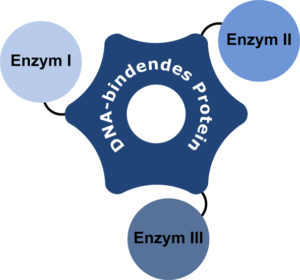Arabella Essert, M.Sc. – Functionalizaton of DNA nanostructures
Arabella Essert, M.Sc. – Functionalizaton of DNA nanostructures
By using enzymes catalyzing consecutive reactions, it is possible to produce organic compounds efficiently and ecologically under mild reaction conditions. Natural metabolic pathways of cells are mimicked to establish such multi-step reaction cascades, whose efficiency can be barely achieved by artificial systems. One of the main reasons is the increase of the reaction rate by forming multiple protein complexes or by immobilization on protein scaffold structures, which limit an uncontrolled diffusion of the intermediates into the bulk phase. Due to the locally increased intermediate concentrations higher rates of the consecutive reactions can be achieved.

The means to create such substrate channels artificially is a hot topic of current scientific research. Thus, this project aims to functionalize different DNA nanostructures by coupling enzymes to investigate the effects on the reaction rates. For a direct conversion of the intermediates, enzymes of a multi-step reaction cascade will be put in close proximity to each other by means of a DNA binding protein. Hence, fusion proteins of a DNA binding protein and their respective enzymes will be generated, recombinantly produced in E. coli and immobilized on tailored DNA nanostructures with different spatial orientation. Subsequently, these different enzyme systems will be compared to the corresponding free enzyme system.
Publications:
, : Dimer Stabilization by SpyTag/SpyCatcher Coupling of the Reductase Domains of a Chimeric P450 BM3 Monooxygenase from Bacillus spp. Improves its Stability, Activity, and Purification. Chem Bio Chem, 25, e202300650.
, : Enhancing the activity of a monomeric alcohol dehydrogenase for site-specific applications by site-directed mutagenesis. PEDS, 36, gzad006.
, , , , , , : Measurement of Minute Liquid Volumes of Chiral Molecules Using In-Fiber Polarimetry. Anal. Chem., 95, 6, 3204–3209.